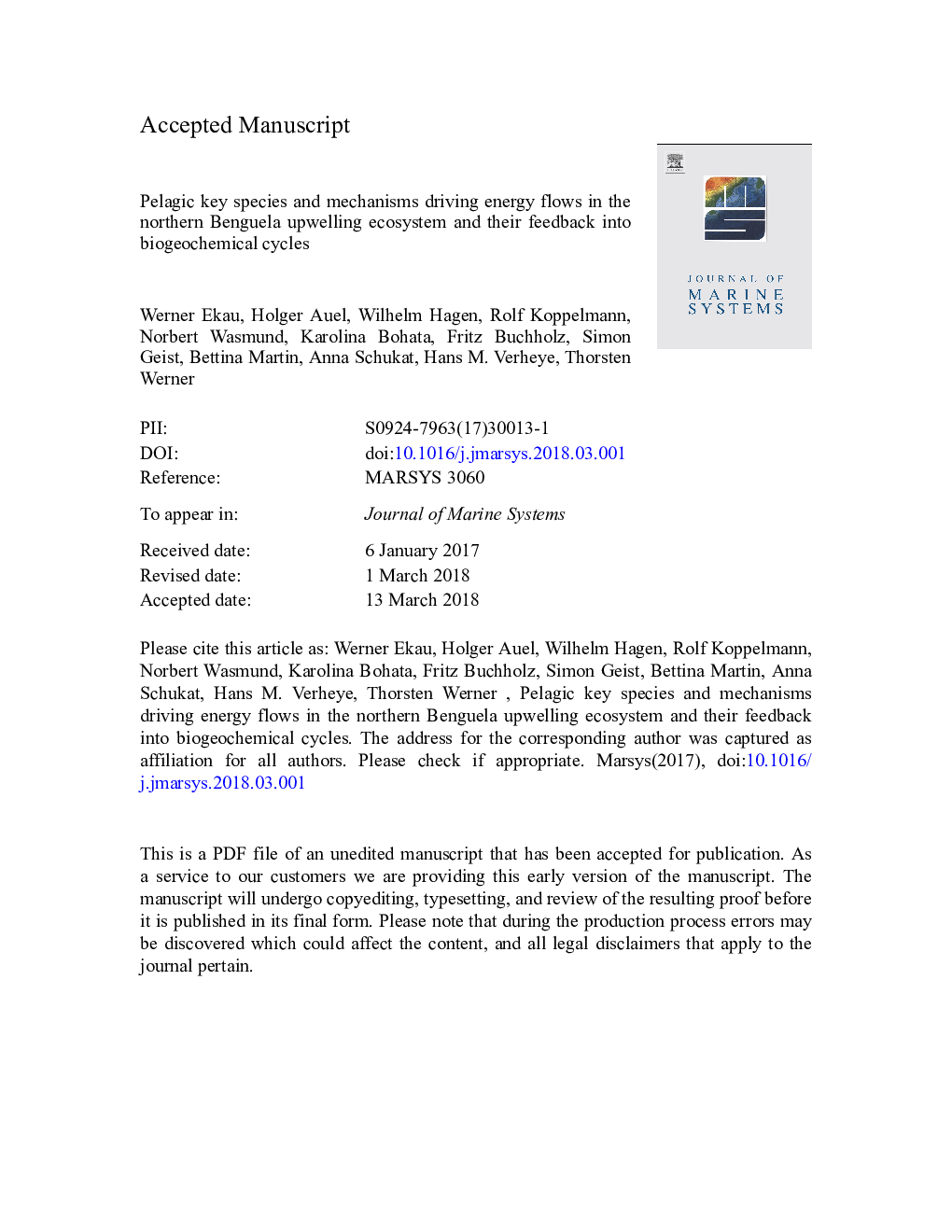| کد مقاله | کد نشریه | سال انتشار | مقاله انگلیسی | نسخه تمام متن |
|---|---|---|---|---|
| 10223873 | 1701062 | 2018 | 38 صفحه PDF | دانلود رایگان |
عنوان انگلیسی مقاله ISI
Pelagic key species and mechanisms driving energy flows in the northern Benguela upwelling ecosystem and their feedback into biogeochemical cycles
دانلود مقاله + سفارش ترجمه
دانلود مقاله ISI انگلیسی
رایگان برای ایرانیان
کلمات کلیدی
موضوعات مرتبط
مهندسی و علوم پایه
علوم زمین و سیارات
اقیانوس شناسی
پیش نمایش صفحه اول مقاله

چکیده انگلیسی
The northern Benguela Upwelling System (nBUS) has been facing increasing temperatures and decreasing dissolved oxygen (DO) levels over the last decades. This has implications for key processes and trophic interactions within the ecosystem including shifts in community composition, distribution ranges, and trophic levels, changes in energy flows and migration patterns with feedbacks to biogeochemical processes. Here we summarise the results gained from the GENUS project (Geochemistry and Ecology of the Namibian Upwelling System) focussing on the geochemical and ecological structures and processes dominating the pelagic component of the nBUS. Spatial and temporal distribution patterns of key species of zooplankton and fish larvae yielded biomass estimates (5 to 81â¯gâ¯Wet Massâ¯mâ2 (10 to 90% quantile) with a median of 19.5â¯gâ¯Wet Massâ¯mâ2 for the upper 200â¯m) and potential impacts on the vertical carbon flux. Vertical distribution ranges of key taxa were determined reflecting their specific abilities to tolerate hypoxia and, hence, their different adaptive mechanisms to cope with the Oxygen Minimum Zone (OMZ). The shoaling of the 2.5â¯mLâ¯O2â¯Lâ1-oxycline (0.24â¯mâ¯yâ1) constrains sensitive species and hampers daily and seasonal vertical migrations. It may also affect the ability of organisms to maintain themselves within nearshore habitats by hindering vertical migration into deeper onshore currents. Respiration rates of key species were determined with one standard method (optode respirometry), showing an average respiration rate of 54.6â¯mLâ¯O2â¯dâ1 (g Dry Mass)â1 for the bulk fraction of mesozooplankton, allowing also the estimate of DO consumption by mesozooplankton at different depth layers. Stable isotopic ratios (N, C) revealed trophic interactions and positions of zooplankton and fish. Our results reveal many players within a small range of trophic levels and a dominance of zooplankton taxa (copepods, euphausiids) in terms of biomass over small pelagic fish (sardine, anchovy), essential to consider for future higher-resolution ecosystem modelling.
ناشر
Database: Elsevier - ScienceDirect (ساینس دایرکت)
Journal: Journal of Marine Systems - Volume 188, December 2018, Pages 49-62
Journal: Journal of Marine Systems - Volume 188, December 2018, Pages 49-62
نویسندگان
Werner Ekau, Holger Auel, Wilhelm Hagen, Rolf Koppelmann, Norbert Wasmund, Karolina Bohata, Fritz Buchholz, Simon Geist, Bettina Martin, Anna Schukat, Hans M. Verheye, Thorsten Werner,